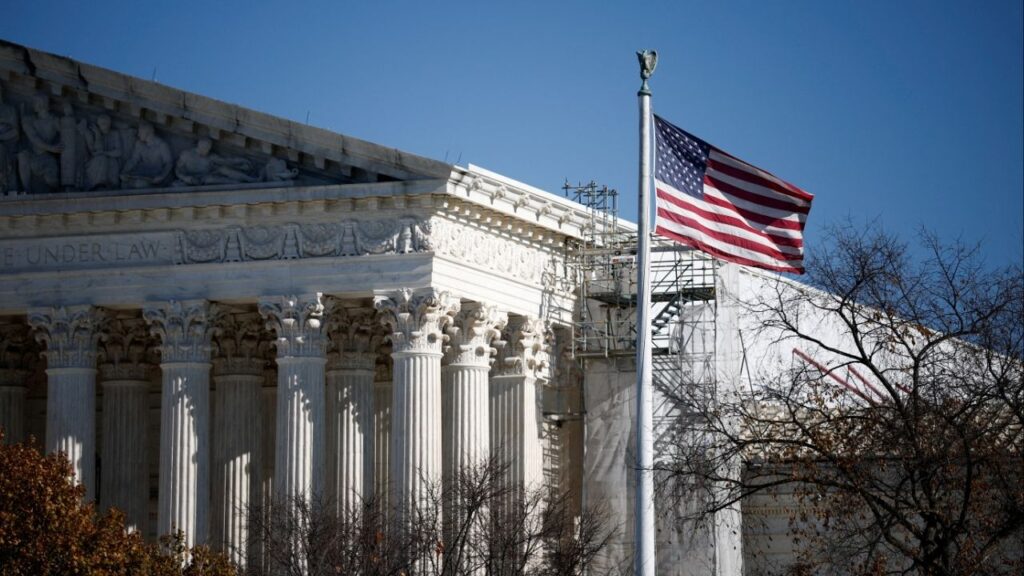The Capitol building in Washington on Oct. 7, 2025. The move deepened the idea that a Vietnam-era law, which says congressionally unauthorized deployments into “hostilities” must end after 60 days, does not apply to airstrike campaigns. (Kenny Holston/The New York Times)
Share
|
Getting your Trinity Audio player ready...
|
WASHINGTON — The Justice Department told Congress this past week that President Donald Trump could lawfully continue his lethal military strikes on people suspected of smuggling drugs at sea, notwithstanding a time limit for congressionally unauthorized deployments of armed forces into “hostilities.”
In a briefing, the official who leads the department’s Office of Legal Counsel, T. Elliot Gaiser, said the administration did not think the operation rose to the kind of “hostilities” covered by the 60-day limit, a key part of a 1973 law called the War Powers Resolution, according to several people familiar with the matter.
In a statement provided by the White House, an unnamed senior administration official said that U.S. service members were not in danger because the boats suspected of smuggling drugs were mostly being struck by drones far from naval ships carrying U.S. forces.
“The operation comprises precise strikes conducted largely by unmanned aerial vehicles launched from naval vessels in international waters at distances too far away for the crews of the targeted vessels to endanger American personnel,” the official said.
About 65 People Killed in 15 Airstrikes
The U.S. military has killed about 65 people across 15 airstrikes on boats in the Caribbean Sea and eastern Pacific so far, and the administration has told Congress that Trump “determined” that the operation counts as a formal armed conflict. On Saturday, the military killed three more men on a boat in the Caribbean, Defense Secretary Pete Hegseth said on social media.
But the stance that the operation does not count as “hostilities” because the people on the boats could not shoot back builds on a precedent established by President Barack Obama during the 2011 NATO air war over Libya, to significant disagreement at the time in Congress and within Obama’s own legal team.
The War Powers Resolution says that a president who unilaterally deploys U.S. forces into hostilities “shall terminate” the operation after 60 days if Congress has not authorized it by then. But the legislation left the term “hostilities” vague.
Under that law, the clock starts no later than when a president submits a required 48-hour notice to Congress. Trump notified Congress about the first strike in his operation on Sept. 4, meaning the 60th day will arrive Monday. That timing had raised the question of whether he would stop or, if not, how he would justify continuing the operation.
When the White House, Pentagon and Justice Department were asked that question by The New York Times on Wednesday, the administration provided a general statement that did not clarify. But Gaiser laid out the administration’s position in briefings to lawmakers and some staffers this past week. His comments were earlier reported by The Washington Post.
The statement from the unnamed official also argued that “even at its broadest,” the War Powers Resolution “has been understood to apply to placing U.S. service members in harm’s way.” And it pointed to two past Office of Legal Counsel opinions discussing military deployment issues — one from a Republican administration and one from a Democratic one.
One memo, from 1984, contained a paragraph discussing what “hostilities” might mean, though it did not take a position. It observed that a House report about the War Powers Resolution had said that term should be interpreted as encompassing a danger of armed conflict, not just combat. It also noted that the Ford administration had argued that “hostilities” referred to a situation in which U.S. armed forces were “actively engaged in exchanges of fire.”
Memo From 1994 About Clinton’s Authority
The other memo, from 1994, was about President Bill Clinton’s authority to unilaterally deploy peacekeeping troops to Haiti. It did not discuss the 60-day limit.
The statement did not cite the Obama-era Libya precedent on the 60-day pullout law — which, while the closest historical analogue, did not lead to an opinion by the Office of Legal Counsel. The office’s top lawyer at the time did not agree with the theory Obama had embraced.
Other lawyers on Obama’s team had come up with that theory. But their argument that the war over Libya did not amount to “hostilities” was based on more than the idea that there was little risk of U.S. casualties, because there were no ground troops and Libyans could not shoot back. The Obama team’s argument also cited other constraining factors that are absent from Trump’s boat attacks, including that the Obama-era operation was a NATO-led multilateral mission to carry out a United Nations Security Council resolution.
By expanding on that precedent, Trump is more deeply entrenching the idea that the 60-day limit does not apply to air wars. That is an important development for the history of a law that presidents of both parties have chafed at over the past half century.
Congress passed the War Powers Resolution near the end of the Vietnam War, after decades in which presidents from both parties had used the large standing armies left in place after World War II to send troops into combat without congressional authorization. The bill contained a package of measures intended to wrest back Congress’ intended constitutional role in deciding when the United States would go to war.
President Richard Nixon vetoed it, calling it an unconstitutional intrusion on his authority as commander in chief. But Congress overrode the veto, so it became law anyway.
Since then, however, some parts of the legislation have eroded.
—
This article originally appeared in The New York Times.
By Charlie Savage and Julian E. Barnes/Kenny Holston
c. 2025 The New York Times Company
RELATED TOPICS:
Categories

MAHA Activists Urge Trump to Fire His EPA Administrator

Meta Strikes Multiple AI Deals With News Publishers

















